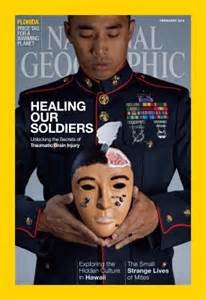National Geographic Magazine ‘Un-Masks’ Soldiers Suffering From Traumatic Brain Injuries
The Fe bruary 2015 Issue of National Geographic features a cover story, “The Invisible War on the Brain,” on soldiers returning home from Iraq and Afghanistan with incredible challenges, not the least of which is the mysterious and devastating effects of traumatic brain injuries from the force of nearby blasts.
bruary 2015 Issue of National Geographic features a cover story, “The Invisible War on the Brain,” on soldiers returning home from Iraq and Afghanistan with incredible challenges, not the least of which is the mysterious and devastating effects of traumatic brain injuries from the force of nearby blasts.
While the evidence for brain injury is very real, veterans are often challenged in their ability to describe the psychological effects, which include confusion, anger and depression, but in ways that defy words. In an effort to promote healing and communication, some soldiers have tried a program that encourages them to paint masks where words cannot articulate the pain.
The article, written by Caroline Alexander, goes on to explain the main problem with diagnosing and treating the blast force injuries, “Despite the prevalence of the condition, the most fundamental questions about it remain unanswered. Not only is there no secure means of diagnosis, but there are also no known ways to prevent it and no cure. Above all, there is no consensus within the medical community about the nature of blast-induced injury or by what mechanism blast force damages the brain.”
Meanwhile, Tender Touch Ministries is currently assisting Orange County, CA veterans of all ages with transitioning back into civilian life, including connecting them to resources to help with medical and psychological needs via the openARMs Program.
Links:
http://ngm.nationalgeographic.com/
https://www.tendertouchministries.org/openarms-program/
Citations:
Alexander, C. (2015, February 1). The Invisible War on the Brain. National Geographic, 35.
